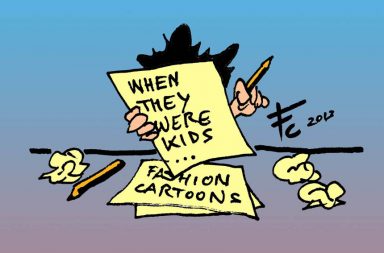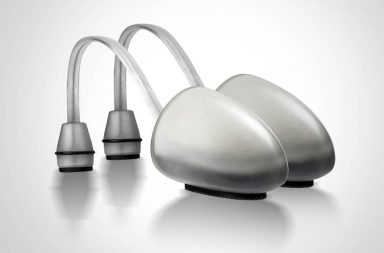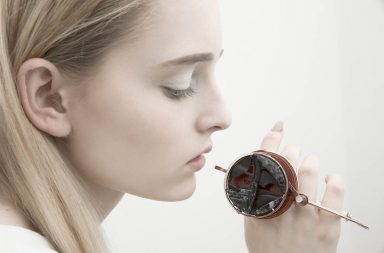The power of colour, extreme design, technology and daring materials are some of the elements that make fashion such an exalted art form, and we like to mention them every chance we get. However, at So Catchy! Where Fashion Begins, we also value the purity of materials, minimalist and well-polished designs that transmit ideas. Today we want to present the creator of sophisticated, simple objects Elena Karavasili (Greece, 1992).

She decided to study Fashion when she moved to New York and saw how everything touches the fashion world. Elena also has had the good fortune to study at two of the most important Fashion schools in the world, Parsons School of Design and the London College of Fsahion.
In London, she studied a Master’s in Fashion Artefacts and her recent collection, “Solid Connection” caught our eye.
To create it, Elena asked herself, “How can traditional materials and artisanry be applied to an unconventional context, such as artefacts, to create commercially viable objects?” For Elena, the materials served not only to guide the design process but also where the pieces are worn.

SC!: Your collection, “Solid Connection”, can be summed up by leather and marble. What was the main challenge of creating these pieces?
EK: The main challenge of this collection was finding the right industry partners. I would not have been able to use marble if it wasn’t for the company Iktinos. Also working with a hard and a soft material and finding the right balance between the two in terms of volume, proportions and structure. It was these challenges though that led me to the products I have today.
SC!: Your work is quite minimalist, simple patterns and mono-colours. What attracts you to this? What do you want to express?
EK: I view minimalism as a type of non-emotive design dictated by geometry and an attention to the material. I think my work reflects my personal style and becomes a part of how I see the world. Designing this was on not a matter of preference but expression. I want to express a need of simplification and purity in design, allowing the customers to have a purely visual response to the receptacles.

SC!: So you’ve studied various specialties within the world of fashion, are there some things that you prefer to design more than others?
EK: I would love to continue designing receptacles and try and place them in the contemporary luxury fashion industry. I feel most comfortable designing accessories I think because accessories allow the wearers to use them in different ways and style them to match their aesthetic.
SC!: What kinds of consumers do you look for?
EK: The consumer I am targeting looks at fashion and accessories as an investment and appreciates craftsmanship and the timeless attributes of the materials used. This consumer is sophisticated, is willing to use and maintain the piece and is attracted by the personal dimensions of luxury that the product represents.

SC!: Do you think people appreciate the value of a product that is far more than a handbag or a purse or is society not the ready for fashion as art yet?
EK: I think people do understand and appreciate it but maybe don’t have space for it in their closets yet. With fast fashion brands taking over, many people are starting to have the need of having timeless quality accessories.
SC!: Do you plan to sell online?
EK: Yes, having online exposure is really beneficial for young designers because of the amount of traffic sites get. It would want to sell at Not Just a Label, Young British Designers, Oki-Ni and through my personal website which is coming soon.

SC!: Tell us about your experience at LCF and Parsons, 2 of the best universities in the world to study Fashion. If you had to choose, which university would you prefer and why?
EK: I am really lucky to have had the opportunity to attend these universities. Parsons taught to have an interdisciplinary approach to design and LCF helped me find out who I am as a designer. I could not pick one because both gave me completely different experiences.
SC!: What´s fashion for you?
EK: Fashion is a way of doing something, whether it is dressing, eating or even daily gestures. Fashion reflects and even sometimes mediates how the world revolves around us.

SC!: Define a fashion artefact.
EK: A fashion artefact can be anything that expresses an idea, is made of interesting materials, has detailed craftsmanship and can interact with people in a unique manner.
SC!: Your inspiration comes from…
EK: Observing. I love looking at architecture and how it transforms a city and shapes how people move around it. I also am really inspired by the materials that I use and try to showcase their features in what I create.
SC!: You can´t stop wearing…
EK: A black t-shirt and a skinny sterling silver hammered ring.

SC!: Websites and Blogs you normally read…
EK: Vogue, i-D, Core 77, New York Times Art & Design Section, Dazed and Confused. These are just a few. I can spend hours researching new trends and ideas because there is so much information out there.
SC!: A fashion designer you truly admire and why?
EK: It is hard to think of only one! Issey Miyake is one of them because his designs offer a refinement of form, creating structurally complicated pieces with innovative materials.
SC!: What is, in your opinion, the future of fashion?
EK: The way I envision the future of fashion is very utilitarian with a focus on sustainable materials. The trend of sustainable fashion has been around for a couple of years but I think slowly it will be applied in more contexts.
Images courtesy of:
Photographer: Eeva Rinne
Make up artist: Helen Hamilton
Translation and Layout by Michael Padilla




